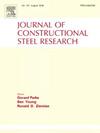高强度钢Q500qE高温力学和蠕变性能试验研究
IF 4
2区 工程技术
Q1 CONSTRUCTION & BUILDING TECHNOLOGY
引用次数: 0
摘要
研究了高强度钢Q500qE的高温力学性能和蠕变行为。进行了高温拉伸试验(20°C - 700°C),以确定屈服强度、弹性模量、极限强度和断裂伸长率的折减系数。在700℃时,屈服强度、弹性模量和极限强度分别下降了80%、53%和81%,而断裂伸长率提高了210%。开发了具有高回归系数的新预测方程来估计这些还原因子。在400°C - 600°C的高温蠕变试验中,应力比为0.4-1.0,使用Norton-Bailey模型进行分析,并通过非线性拟合进行校准。结果表明,温度和应力比的增大会加速蠕变应变,缩短蠕变寿命。在600℃时,即使应力比较低(0.5),试样也会在549 min内进入加速蠕变阶段,并发生断裂。所建立的预测方程和标定模型为Q500qE的高温性能提供了可靠的估计,为其在高温环境中的应用提供了有价值的指导。本文章由计算机程序翻译,如有差异,请以英文原文为准。
Experimental investigation of high-temperature mechanical and creep properties of high-strength steel Q500qE
This study investigates the high-temperature mechanical properties and creep behavior of high-strength steel (HSS) Q500qE. High-temperature tensile tests (20 °C–700 °C) were conducted to determine reduction factors for yield strength, elastic modulus, ultimate strength, and elongation at break. At 700 °C, yield strength, elastic modulus, and ultimate strength decreased by 80 %, 53 %, and 81 %, respectively, while elongation at break increased by 210 %. New predictive equations with high regression coefficients were developed to estimate these reduction factors. High-temperature creep tests at 400 °C–600 °C under stress ratios of 0.4–1.0 were analyzed using the Norton-Bailey model, calibrated through nonlinear fitting. Results indicate that increasing temperature and stress ratio accelerate creep strain and shorten creep life. At 600 °C, even with a low stress ratio of 0.5, the specimen entered the accelerating creep stage and fractured within 549 min. The proposed predictive equations and calibrated model offer reliable estimates of Q500qE's high-temperature performance, providing valuable guidance for its application in elevated-temperature environments.
求助全文
通过发布文献求助,成功后即可免费获取论文全文。
去求助
来源期刊

Journal of Constructional Steel Research
工程技术-工程:土木
CiteScore
7.90
自引率
19.50%
发文量
550
审稿时长
46 days
期刊介绍:
The Journal of Constructional Steel Research provides an international forum for the presentation and discussion of the latest developments in structural steel research and their applications. It is aimed not only at researchers but also at those likely to be most affected by research results, i.e. designers and fabricators. Original papers of a high standard dealing with all aspects of steel research including theoretical and experimental research on elements, assemblages, connection and material properties are considered for publication.
 求助内容:
求助内容: 应助结果提醒方式:
应助结果提醒方式:


